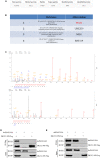Duck PIAS2 Promotes H5N1 Avian Influenza Virus Replication Through Its SUMO E3 Ligase Activity
- PMID: 32595623
- PMCID: PMC7300270
- DOI: 10.3389/fmicb.2020.01246
Duck PIAS2 Promotes H5N1 Avian Influenza Virus Replication Through Its SUMO E3 Ligase Activity
Abstract
The protein inhibitor of the activated STAT2 (PIAS2) has been implicated in many cellular processes and can also regulate viral replication in mammals. However, the role of PIAS2 in the highly pathogenic avian influenza virus (HPAIV) H5N1 replication in ducks is still unclear. Through liquid chromatography-tandem mass spectrometry (LC-MS/MS) assay, we identified that duck PIAS2 (duPIAS2) was one protein that interacted with the nucleoprotein (NP) from the H5N1 HPAIV strain of DK212. Through confocal microscopy images and Co-IP assay, we confirmed NP could interact with duPIAS2. Overexpression of duPIAS2 in primary duck embryo fibroblast (DEF) cells was shown to promote DK212 replication, and knockdown of duPIAS2 could repress DK212 replication. We further found duPIAS2 could promote NP SUMOylation through duck SUMO1 (duSUMO1), and the potential SUMOylation sites of NP were at lysines 7, 48, and 87. Furthermore, duPIAS2 promoted the replication of DK212, here relying on the activity of its SUMO E3 ligase. Duck SENP1 (duSENP1), a deSUMOylation enzyme, could repress NP SUMOylation and also inhibit DK212 replication. Together, we identified duPIAS2 could interact with NP and that duPIAS2 promoted H5N1 HPAIV replication, which might be related to NP SUMOylation.
Keywords: H5N1 avian influenza virus; duck; nucleoprotein; protein inhibitor of activated STAT2; protein–protein interactions.
Copyright © 2020 Zu, Xue, He, Shi, Zhang, Wu, Li, Liu, Huang, Jiao and Liao.
Figures







Similar articles
-
Duck PIAS2 negatively regulates RIG-I mediated IFN-β production by interacting with IRF7.Dev Comp Immunol. 2020 Jul;108:103664. doi: 10.1016/j.dci.2020.103664. Epub 2020 Mar 6. Dev Comp Immunol. 2020. PMID: 32151676
-
Host immune responses of ducks infected with H5N1 highly pathogenic avian influenza viruses of different pathogenicities.Vet Microbiol. 2013 Oct 25;166(3-4):386-93. doi: 10.1016/j.vetmic.2013.06.019. Epub 2013 Jul 9. Vet Microbiol. 2013. PMID: 23920409
-
Efficient strategy for constructing duck enteritis virus-based live attenuated vaccine against homologous and heterologous H5N1 avian influenza virus and duck enteritis virus infection.Vet Res. 2015 Apr 16;46(1):42. doi: 10.1186/s13567-015-0174-3. Vet Res. 2015. PMID: 25889564 Free PMC article.
-
PA-X decreases the pathogenicity of highly pathogenic H5N1 influenza A virus in avian species by inhibiting virus replication and host response.J Virol. 2015 Apr;89(8):4126-42. doi: 10.1128/JVI.02132-14. Epub 2015 Jan 28. J Virol. 2015. PMID: 25631083 Free PMC article.
-
Avian influenza in birds and mammals.Comp Immunol Microbiol Infect Dis. 2009 Jul;32(4):255-73. doi: 10.1016/j.cimid.2008.01.001. Epub 2008 May 15. Comp Immunol Microbiol Infect Dis. 2009. PMID: 18485480 Review.
Cited by
-
Clade 2.3.4.4b highly pathogenic avian influenza H5N1 viruses: knowns, unknowns, and challenges.J Virol. 2025 Jun 17;99(6):e0042425. doi: 10.1128/jvi.00424-25. Epub 2025 May 9. J Virol. 2025. PMID: 40340397 Free PMC article. Review.
-
Viruses, SUMO, and immunity: the interplay between viruses and the host SUMOylation system.J Neurovirol. 2021 Aug;27(4):531-541. doi: 10.1007/s13365-021-00995-9. Epub 2021 Aug 3. J Neurovirol. 2021. PMID: 34342851 Free PMC article. Review.
-
NS1: A Key Protein in the "Game" Between Influenza A Virus and Host in Innate Immunity.Front Cell Infect Microbiol. 2021 Jul 13;11:670177. doi: 10.3389/fcimb.2021.670177. eCollection 2021. Front Cell Infect Microbiol. 2021. PMID: 34327148 Free PMC article. Review.
References
-
- Brown J., Conn K., Wasson P., Charman M., Tong L., Grant K., et al. (2016). SUMO ligase protein inhibitor of activated STAT1 (PIAS1) is a constituent promyelocytic leukemianuclear body protein that contributes to the intrinsic antiviral immune response to herpes simplex virus 1. J. Virol. 90 5939–5952. 10.1128/jvi.00426-16 - DOI - PMC - PubMed
LinkOut - more resources
Full Text Sources
Miscellaneous

